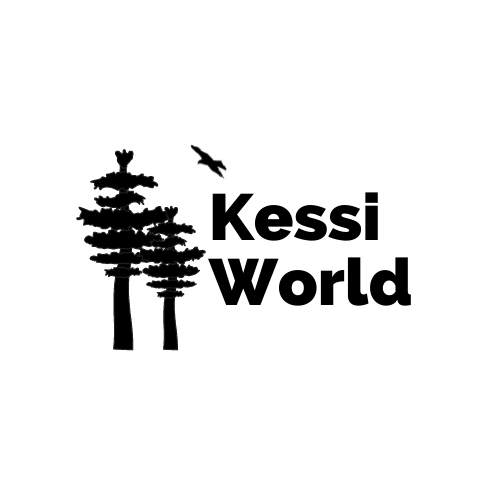How to plan an epic Oregon Coast road trip
A Pacific Northwest local shares all you need to plan an epic Oregon Coast road trip. Includes three sample itineraries (Seattle to San Francisco), interactive map, videos, beaches, mossy trees, rock stacks, lighthouses—an excellent resource for first-time visitors.
This article about planning an Oregon Coast road trip is for you if:
- You’re visiting the Oregon Coast for the first time.
- You want to explore the Oregon Coast but would like some help figuring out where to begin.
- You seek reliable local knowledge for travel in the Pacific Northwest.
- You’re an Oregon local wanting ideas for visitors.
An Oregon Coast road trip can be sublime when the connection with the natural world aligns just right. But putting together the right itinerary to capture the essence of a pristine 363-mile coastline can be tricky — especially for those who earnestly appreciate all the healing properties nature provides. I grew up in Oregon and spent a lifetime visiting various destinations along the Pacific Ocean — including six recent road trips up and down Oregon Coast Highway 101.
My mystic journey has been one of amazing transformation from a person who rushed and succumbed to travel anxiety toward a calming inward peace that guides my movement. I understand what it’s like to try to move from a hectic daily life to connecting with nature. I’ve lived in nature my whole life, but I have found better techniques to quickly connect that I can share with you–and help you integrate it into your own experience, enjoying a meaningful connection on the Oregon Coast.
This guide to planning the best Oregon Coast road trip for you has several essential components, and you can follow along with the table of contents below. If you’re looking for constant entertainment, along the lines of action-packed itineraries, I can point you in the right direction. But the work of Nature Connection, where you deepen self-clarity, is much slower. Accessing your own wild nature means you’ll be more present to yourself, your travel companions, and the magic of the Oregon Coast. I would like to help you make your visit epic.
Best for first-time visitors or those with limited time on the Oregon Coast.
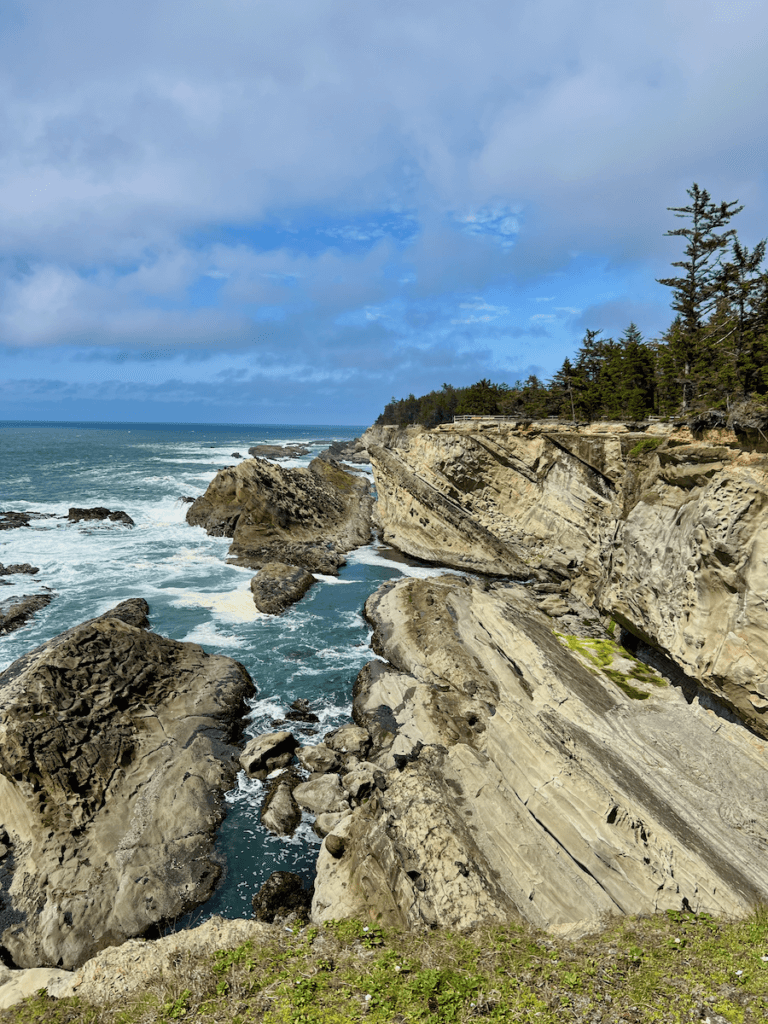
Table of Contents: How to make the most of your Oregon Coast Road Trip.
- Why should you listen to me?
- Let me help you plan an epic PNW trip.
- Why Nature Connection matters
- Forest Bathing on the Oregon Coast
- Important activities to plan
- Oregon Coast Beaches
- Rock Stacks and Tide Pools
- Visit a Lighthouse
- Old-growth rainforests & mossy goodness
- The Oregon Dunes
- Where to see wildlife on the Oregon Coast
- Where to stay on the Oregon Coast
- Oregon Coast Itineraries
- Olympic Peninsula and Oregon Coast Itinerary
- Seattle to San Francisco Road Trip
- Frequently Asked Questions
- Interactive Map
Why should you listen to Matthew Kessi (that’s me)?
- The Pacific Northwest is my lifelong playground.
- Since my family lives in Oregon, I visit the Oregon Coast frequently to update my knowledge, including a yearly road trip down the entire stretch of Highway.
- As a former travel industry professional (for 25 years), my experience guiding people around Oregon and Washington State gives me valuable insight into the right balance between what is possible and rewarding.
- Unlike big travel websites (and AI), I’ve been to all the places, tested the ideas, eaten the food, and taken photos. I don’t get compensation for naming specific locations–my recommendations come from the heart.
- My spiritual journey has been one of amazing transformation from a person who rushed and succumbed to travel anxiety toward a calming inward peace that guides my movement. I understand what it’s like to try to move from a hectic daily life to connecting with nature. I’ve lived in nature my whole life, but I have found better techniques to quickly connect that I can share with you–and help you integrate it into your own experience, enjoying a meaningful connection on the Oregon Coast.
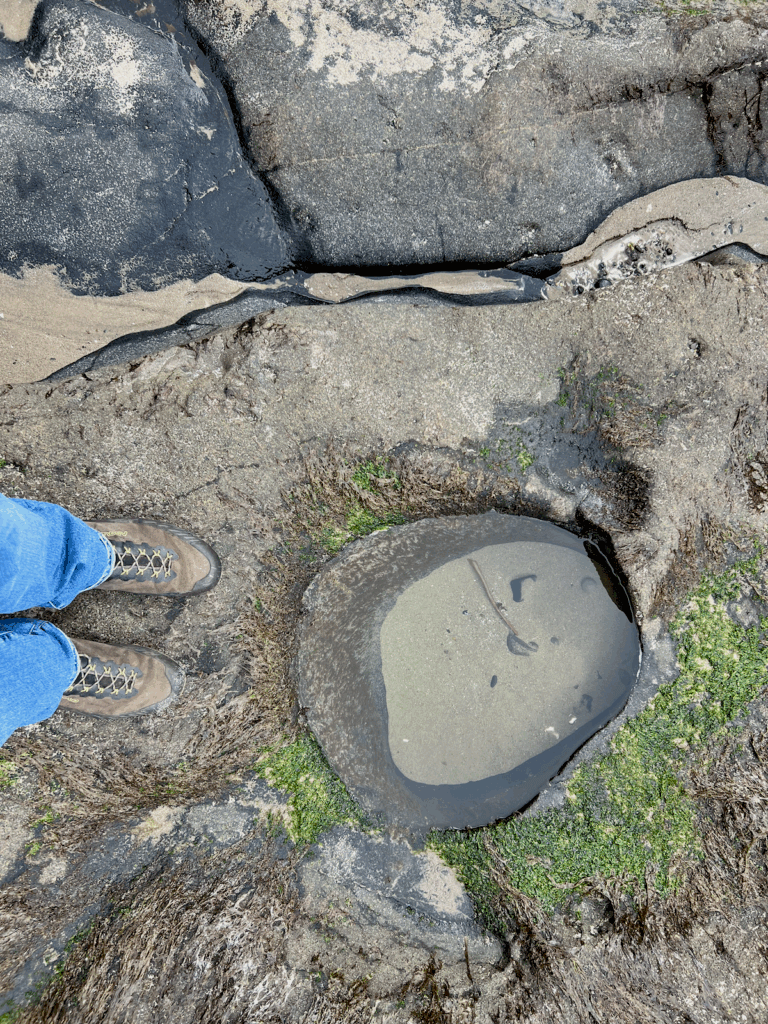
Experience a 20-minute Oregon Coast Nature Connection.
Quiet your mind, open your heart, and allow your intuition to flow by following my guided Nature Connection Experiences, several filmed on the Oregon Coast.
A 20-minute guided Nature Connection video can help you deepen your mindfulness of the natural world in ways that will bring healing, wellness, and awakening.
Not quite meditation, not quite contemplation, and a lot of work with Nature’s Intelligence, this experience helps wake up your inner self in ways that might surprise you.
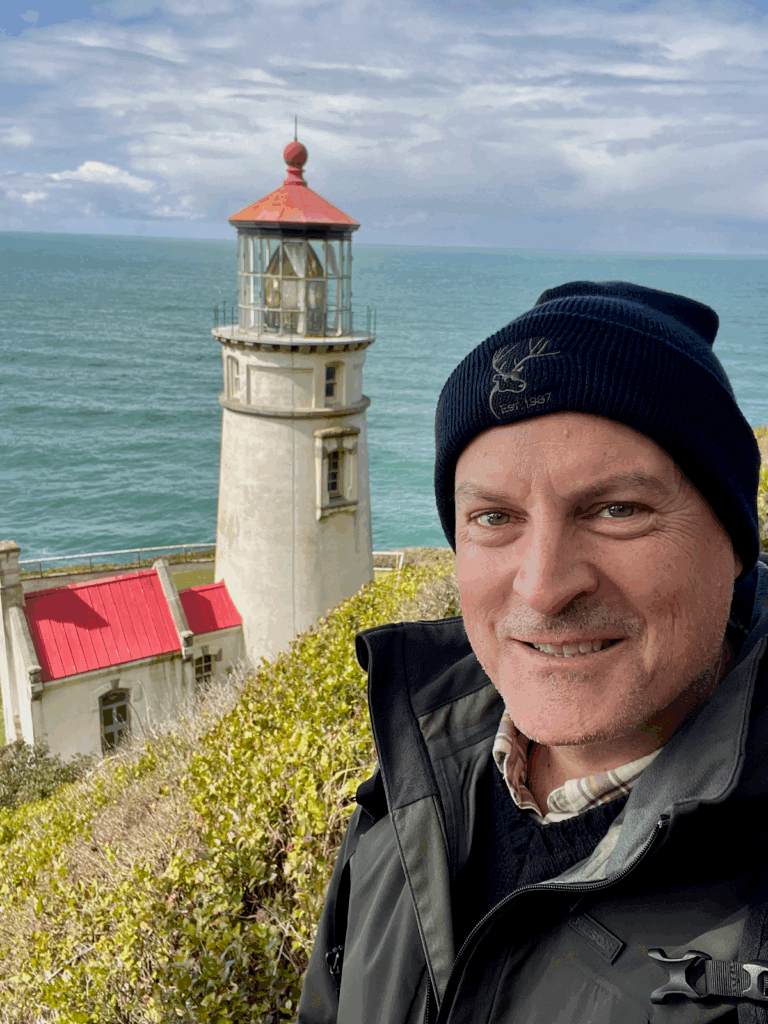
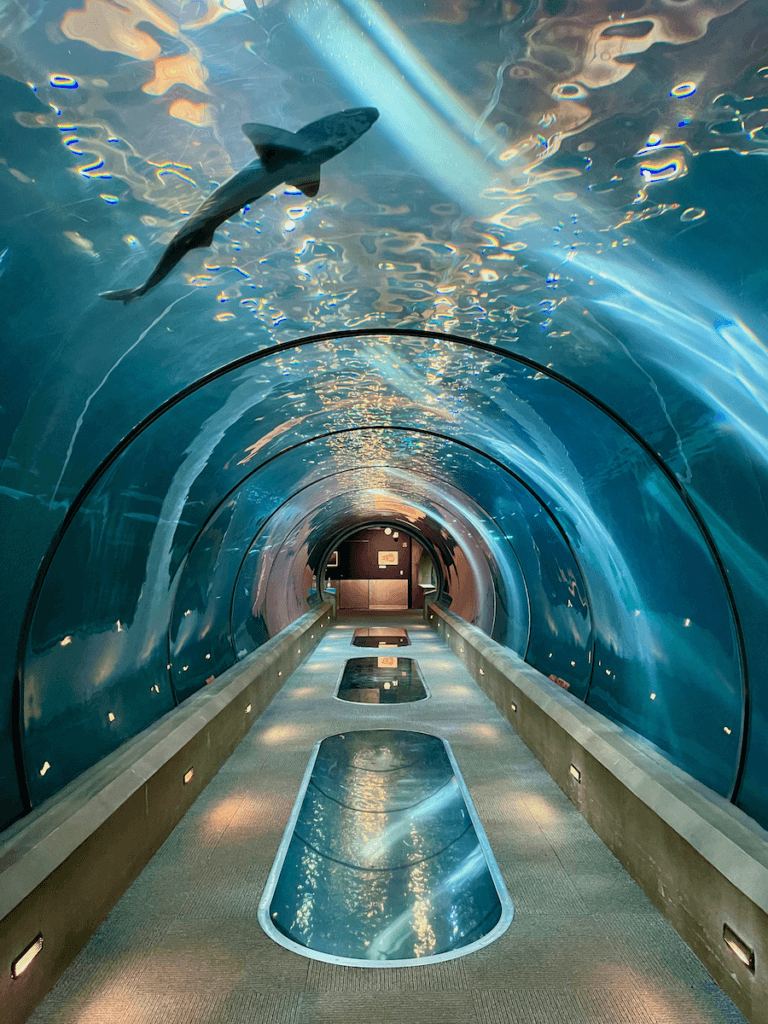
Let me help you plan an epic trip to the Oregon Coast or the Pacific Northwest.
If you’re new to Oregon State or interested in detailed nature connection options, let me help you plan an epic Oregon Coast road trip. I offer Zoom meetings, during which our conversation leads to a customized itinerary for an exciting and thoughtful journey. I will also provide honest feedback about your planning work-in-progress. Click here for more information.
Why nature connection matters.
The difference between an “eh” experience and a memorable one is about grounding with the natural environment. You can probably think back to wonderful travel experiences, and the common denominator would be feelings of belonging — or connection — to yourself, your companions, and the destination.
Whether that is a fun conversation with a server at a quirky restaurant or sighting a rare bird landing on your veranda, the magic occurs when you’re open to the beauty of a connection. It’s the wonder that awakens in your heart and soul.
And often, the loudness of modern culture, especially on vacation in an unfamiliar place, adds static. The static prevents a total opening up to the possibilities, consciously or subconsciously. That’s why — without grounding — you might return home feeling like you need a vacation from your vacation.
Nature Connection focuses on the “loudness of the ocean” — making your connection to the land the priority of travel. But don’t worry. You can still enjoy your favorite experiences, like witnessing droplets falling from a mossy branch, dodging drift logs on an expansive beach, or canoeing in a glacial lake. Overlaying a nature-forward focus makes all these things more meaningful because you’re more connected to heart and soul — or intuition.
Over my lifetime, I’ve developed six steps guaranteed to help anyone practice a nature-forward connection. Staying grounded and mindful takes as little as 30 minutes daily. I give you all the information in this article, How to transform your travel experience with nature-forward vacations.
My information, including the itineraries, incorporates mindfulness in nature into the mix. While practicing a nature-forward focus in these soul-nourishing locations doesn’t take longer, it will transform how you experience the Oregon Coast, Pacific Northwest, and travel.
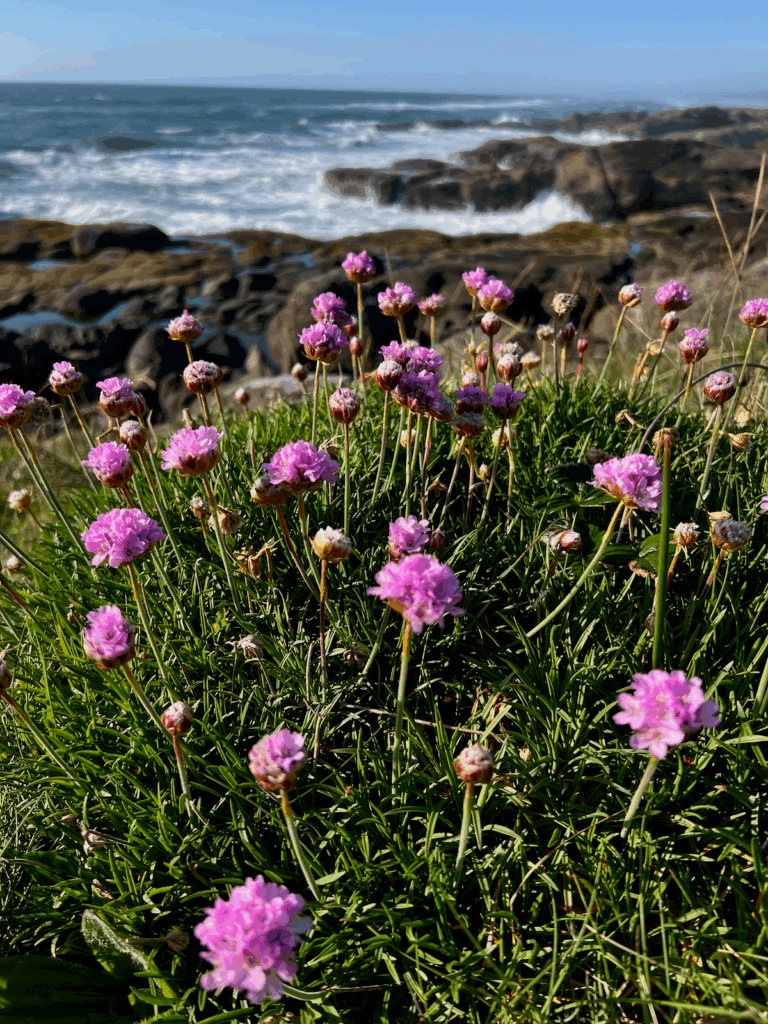
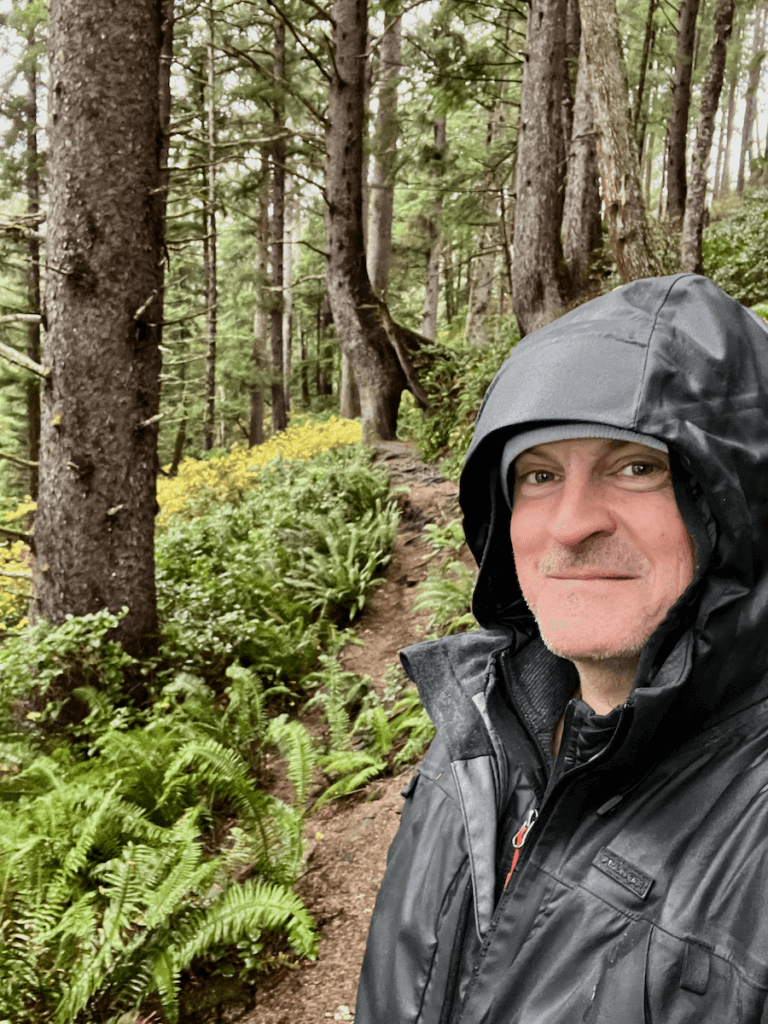
Forest Bathing on the Oregon Coast?
Forest bathing, or Shinrin Yoku, is a concept that originated in Japan in the 1980s as its population migrated from rural to urban living to support a booming economy based on manufacturing and technology. However, in this transition, companies found that their employees were prone to sickness and burnout.
Japan’s government commissioned studies to get to the root problem. They found empirical proof that a mindful re-connection to the Natural World worked well as a remedy against the stress of daily life in a demanding corporate environment.
The concept of “forest bathing” comes from the phytoncides and other essential oils emitted from forest trees. They quite literally rain down. Several studies have shown that the fragrance of phytoncides reduces stress and promotes immunocyte growth, including natural killer (NK) cells.
Furthermore, a growing body of research points to the beneficial effects of exposure to the Natural World on health, reducing stress, and promoting healing. Some studies further clarify that only 20 minutes daily (of immersive Natural experiences) are essential to producing lasting benefits such as lower blood pressure, higher concentration, improved mental health, regulating cortisol levels, neutralizing inflammation, and even higher sexual satisfaction.
If you’re interested in more information, I’ve written a step-by-step guide, “Forest Bathing for Beginners” that offers simple and proven ways to find more meaning and fulfillment in a deeper Nature Connection.

Where can you go Forest Bathing on the Oregon Coast?
The answer is anywhere! If you want some pointers, check out my article, “Forest Bathing Near Me — a guide to finding the best places to connect with Nature.”
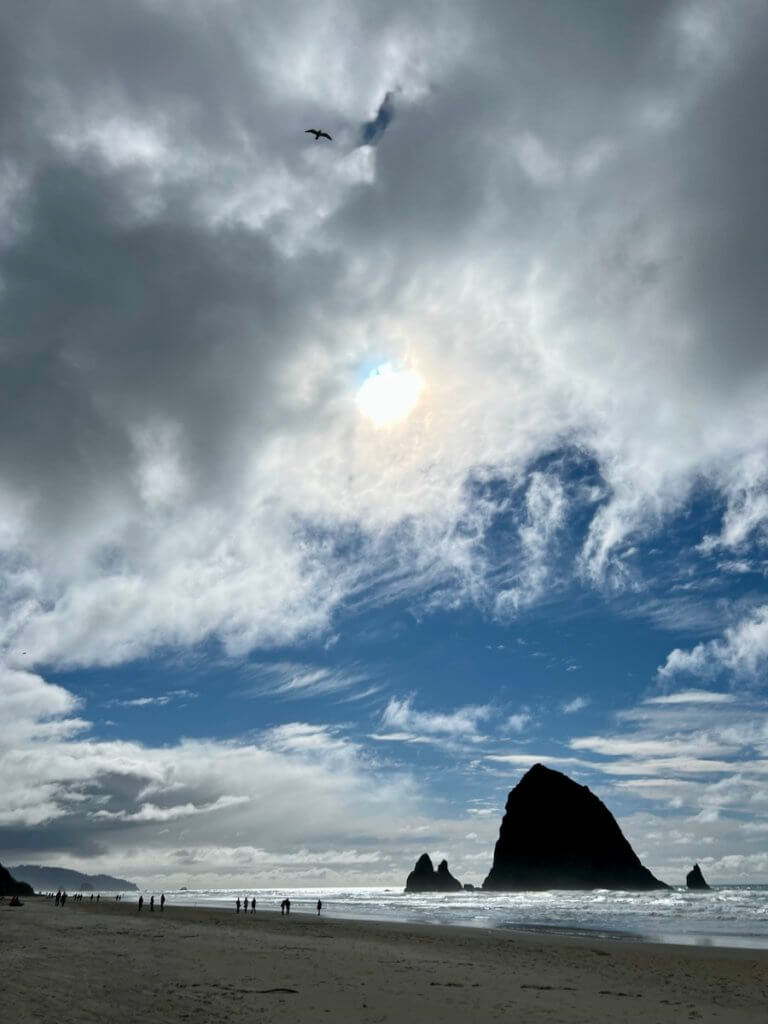
What things should you plan on an Oregon Coast road trip?
Look at this journey as a collection of different experiences instead of a passport stamp of places. Sure, there are top 10 lists online, but I strongly recommend you trade quantity for quality. This means incorporating more experiences into each stop — and taking fewer stops.
What do I mean? There are nine prominent lighthouses on the Oregon Coast, many offering similar views and adding at least an hour to your road trip. If you’re not a lighthouse enthusiast, it might be a better use of your time to select one or two lighthouses to see and continue on to other experiences. In this case, I would suggest visiting Heceta Head Lighthouse or Yaquina Bay Outstanding Natural Area in Newport.
If you’re short on time — anything less than three days — consider choosing one thing in each category of nature to use as your anchor and allow spontaneity to work with filling in your time.
What are the anchor experiences on an Oregon Coast road trip?
For shorter trips, there are six main nature experiences to enjoy. Select one thing in each category to use as your anchor. Then, allow spontaneity, such as a soulful wander on an endlessly sandy beach.
- Walking on an endless sandy beach (for example Gold Beach)
- Rock Stacks (like Ecola State Park)
- A lighthouse (like Yaquina Bay in Newport)
- Visiting an old-growth or mature forest (like Oswald West State Park)
- The Oregon Dunes
- Wildlife viewing
Long walks on the beach? Yes, please.
The Oregon Coast is famous for its expansive sandy beaches. This is the meeting place between crashing waves of the Pacific Ocean and dramatic coastal terrain. The Oregon Coast is also unique because the entire coastline is public land. There are no private beaches. On the other hand, be aware that access to beaches can be on private land–be sure to use a designated access point to reach the beach.
Iconic Oregon Beaches
Cannon Beach is the most iconic beach on an Oregon Coast road trip. Haystack Rock is often the poster “rock stack” for Oregon. I grew up visiting this beach yearly with my family; the town is adorable. Given its proximity to Rose City, this is also a popular location for day trips from Portland—it gets jam-packed during popular times.
Further south, Rockaway Beach is beloved by residents because of its seven mile long uniterrupted span of fine sandy goodness.
The beaches around Bandon are also famous for soulful walks. This area of the Southern Oregon Coast boasts many interesting rock stacks, making for fun experiences and dramatic photos.
Gold Beach, near the Oregon/California border, offers fewer visitors and long walks galore.
There are so many options for wonderful beaches that I suggest pulling off the road where the spirit moves you. Sunset can be a fantastic time for a long walk. Be sure to research the tides and never leave your back faced against the water–sneaker waves are a real occurrence.
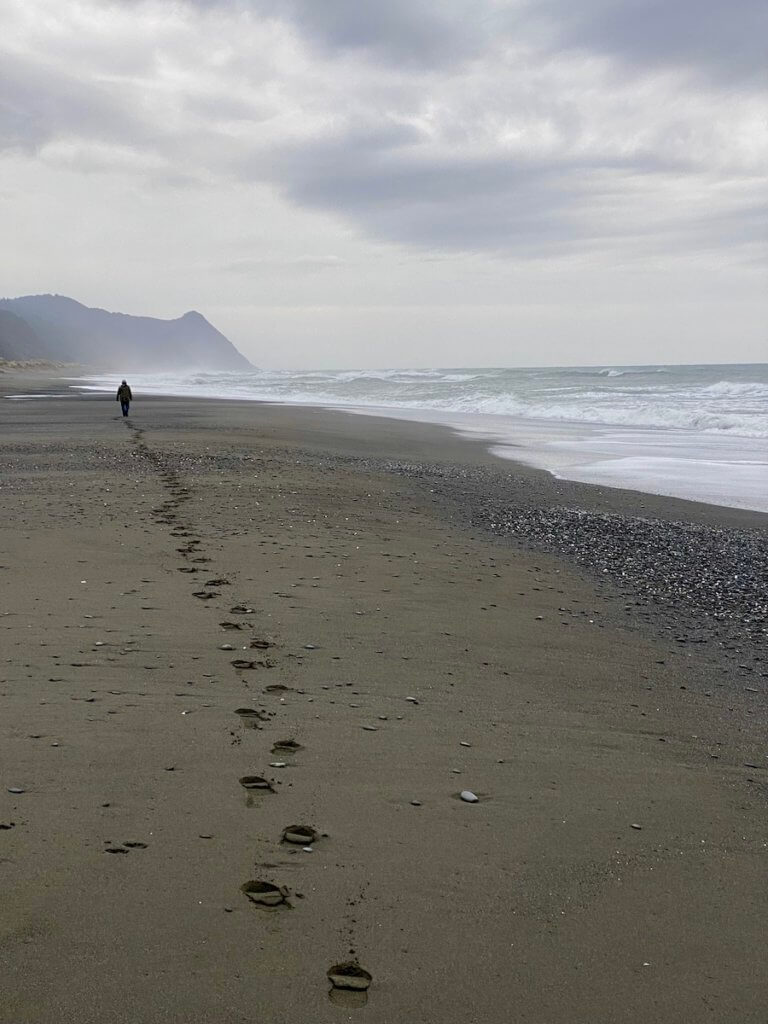
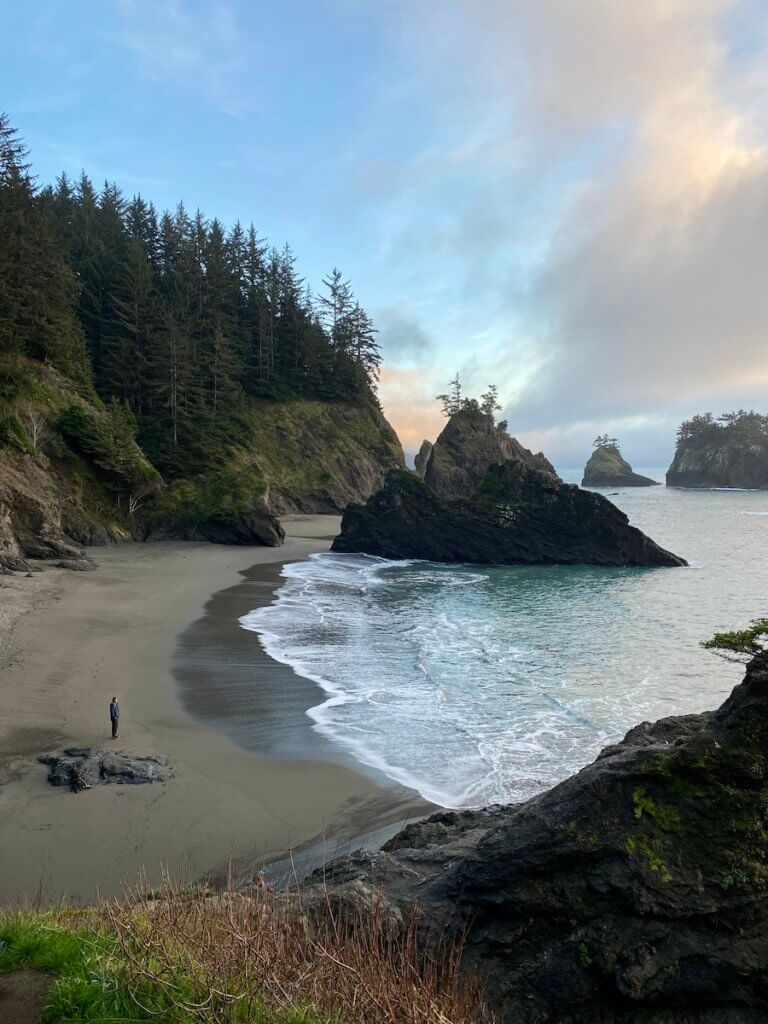
What are rock stacks?
Rock stacks are remnants of land that have eroded over thousands of years. Some are from volcanic activity, making more interesting blowholes and punch bowls. Others, like Haystack Rock, are stand-alone wonders. Rock formations also provide a harbor for sea life, which are the areas to consider when exploring tide pools.
These famous features begin around Ecola State Park and continue down the 363-mile coastline to Brookings, Oregon.
Rock Stacks of the North Coast
Ecola State Park is the most famous viewpoint in movies from The Goonies to the Twilight series. I regularly visit this park near Cannon Beach. There is a $10 fee to park for the day, and you’ll see surfers departing from Indian Beach. You can enjoy some wonderful, and busy, hikes in this area too.
Rock Stacks of the Central Coast
The best example of volcanic formations turned fantastic rock features occurs in the stretch from Yachats, Oregon, to the start of the Oregon Dunes. This experience is different and worth a stop or two in this area. Yachats is one of my favorite places to stay on the Oregon Coast.
If time is short, the Cape Perpetua area offers convenient stops with minimal walks to crowd pleasers like Thor’s Well and the Cape Perpetua Viewpoint.
Rock Formations of the Southern Oregon Coast
Shore Acres State Park requires an investment of time to get off the main Highway 101, but it’s worth the effort. Just south of the North Bend/Coos Bay Area, this region of the coast offers up close viewing of the tectonic plates grinding against each other, shifting the continental plate up at a 45-degree angle. Plus, there is a fantastic botanical garden and two other state parks nearby: Sunset Bay State Park boasts the warmest water for swimming, and Cape Arago offers dramatic views with an active sea mammal population.
Further south, the Samual Boardman Scenic Area (between Gold Beach and Brookings) offers several wonderful viewpoints of dramatic arches and rock stacks. This natural wonderland also offers some great hikes. Natural Bridge and Secret Beach are two of the most photographed.
Oregon Coast Road Trip essential: Visit a Lighthouse
The stunning, dramatic beauty of the Oregon Coast also made it a treacherous place for maritime operations. A series of nine prominent lighthouses (two other more recent locations) were built around the turn of the 20th century. They harken back to a day when lonely caretakers burned midnight oil to keep ships safe from the shore.
As a rule of thumb, each of the main rivers that flow from the Coastal Range to the Pacific Ocean has a lighthouse: Yaquina River, Umpqua River, Coquille River, Rogue River. The dramatic Tillamook Head Lighthouse is visible from Indian Beach at Ecola State Park–a rocky island perch.
Unless you are an avid lighthouse enthusiast, it isn’t necessary to visit all of them, or even most of them. For a road trip on the Oregon Coast I suggest visiting one or two. These are the best options, including locations that allow for hiking and other coastal experiences at the same time.
Yaquina Bay Outstanding Natural Area
This is the tallest lighthouse still active on the Oregon Coast. There is an entrance fee here, or you can use the America the Beautiful National Park annual pass. Aside from the statuesque lighthouse in a prominent location in Newport, Oregon, the natural features are an Outstanding Natural Area.
Heceta Head Lighthouse (photo shown)
My favorite lighthouse and general Nature location on the Oregon Coast is about 20 miles south of Yachats. This location is fantastic for the beach below, with tide pools to explore at low tide, a whimsical Bed & Breakfast, dramatic waves crashing against the rocks below the iconic lighthouse, and a soul-nourishing hike through a magical forest to Hobbit Beach—a long sandy stretch of Nature’s medicine. If you are short on time and want to select one quintessential Oregon Coast lighthouse and accompanying experiences, this is your stop!
Cape Blanco Lighthouse
This beautiful lighthouse marks Oregon’s westernmost point! Just north of cute little Port Orford, Cape Blanco takes a little more time to drive into the State Park, but the landscape is breathtaking. In the spring, hike among blooming irises and wander on empty beaches as far as the eye can see.
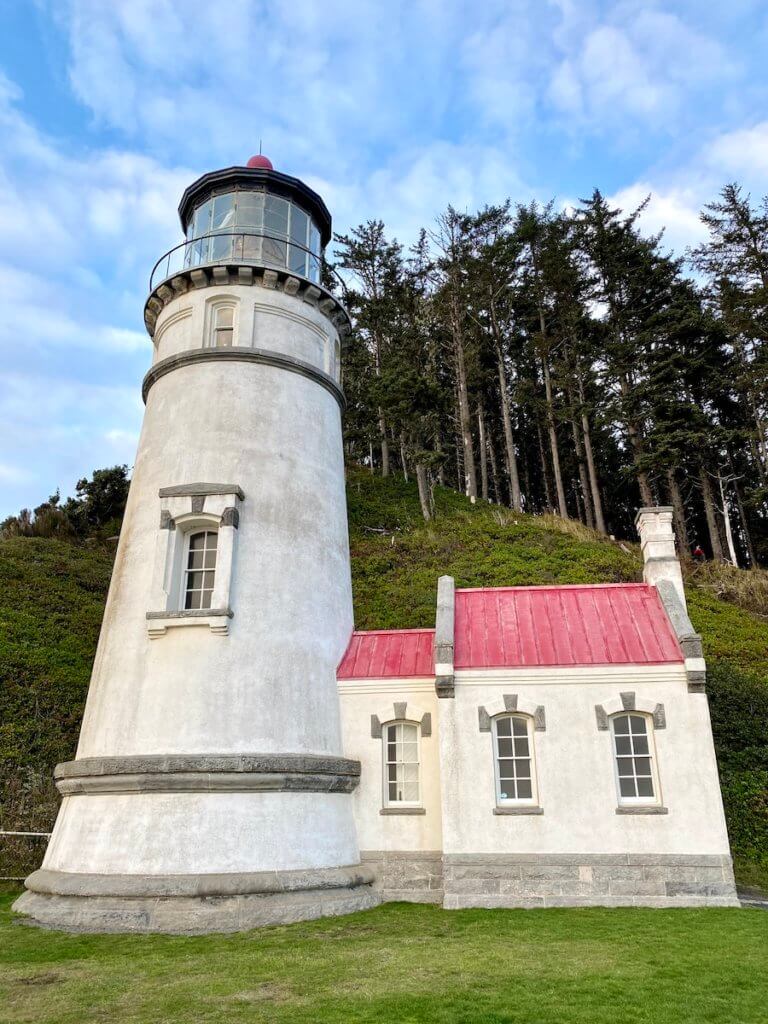
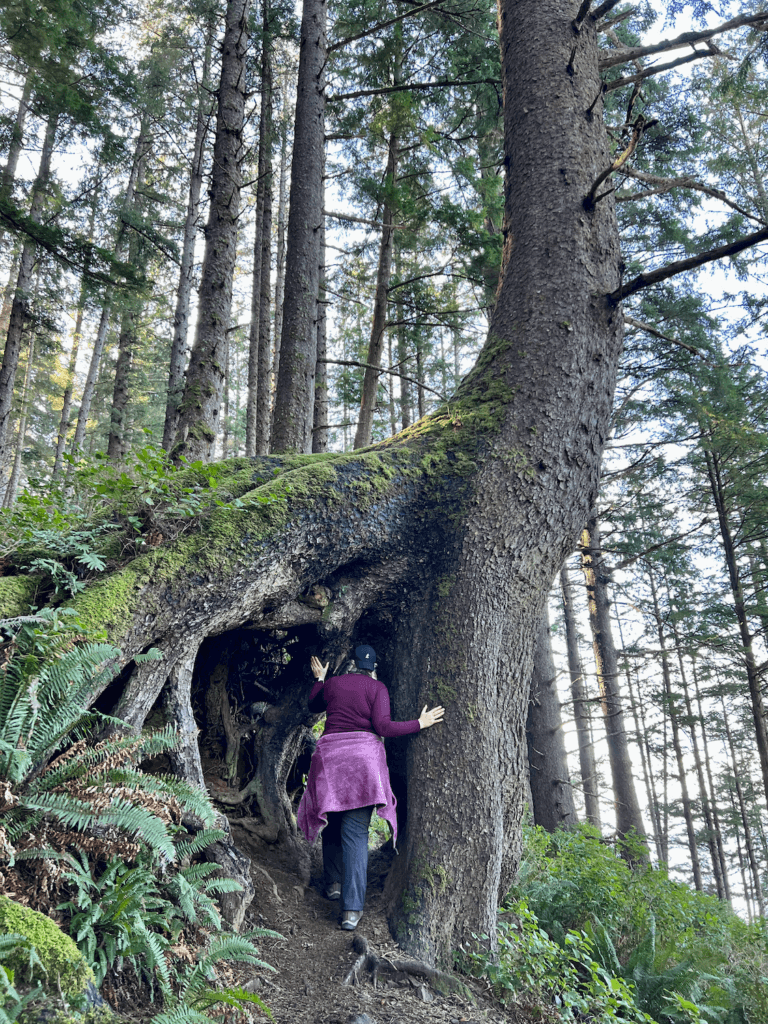
Old-growth forest and mossy delights–an Oregon Coast hike.
To be clear, 99% of all coastal old-growth forests were harvested in the early/mid-1900s. But this means that many timber stands that were replanted are reaching maturity, replicating environments similar to pre-logging in the region.
It is part of any Oregon Coast Road Trip experience to enter the magical hobbit worlds, with their twisting tree trunks, hidden dens flowing with electric green moss, and beautiful sword ferns. I suggest you read another article about Soulful Hikes on the Oregon Coast for more information about this topic.
Ecola State Park and Heceta Head are the best stops to incorporate many features, like beaches, rock stacks, and deep forest, and are already listed above. But if time allows, I suggest these other locations to experience some forest magic.
Oswald West State Park
This park is named after Oregon’s governor known for allocating the beaches public land, and signing the suffrage bill that allowed Oregon women to vote in the early 1900s: Oswald West. He got the idea to make the beaches public land while riding a horse around the dramatic Neah-kah-Nee Mountain, which now hosts this beautiful Oregon State Park.
I’ve scoured the Oregon Coast for stands of old-growth trees, and Oswald West State Park is the only place I’ve found where the majestic beauties grow down to the sea. The location is convenient, just south of Cannon Beach on the way to Manzanita. It makes a great and easy stop on an Oregon Coast Road Trip.
Other locations that make great stops include the Rockaway Big Tree Trail, Wilder Trails, Mike Miller Park in Newport, and the Francis Shrader Old Growth Trail, near Gold Beach.
The land of sand: Oregon Dunes
Have you ever wondered where the idea for the story Dune originated? Frank Herbert studied oceanography in the 50-mile stretch of sand between Florence and Coos Bay. His time among the fascinating hills of sand inspired his writing of the seminal classic Dune.
There are many ways to play in this region, but on an Oregon Coast Road Trip, you may consider one of many viewpoints or short hikes. Wearing gators around your shoes and pants is helpful if you plan to hike. The summer season gets busy with dune buggy tours and other motorized things.
Making a stop offers a quintessential Oregon Coast experience, and AllTrails has many short and long hikes to choose from. I like the John Dellenback Trail for its diversity of terrain, including five miles of dunes, a forested boardwalk, and an escape to a sandy beach.
At the very least, find a viewpoint along the way to pull off and gaze at the wonder of fifty miles of sand.
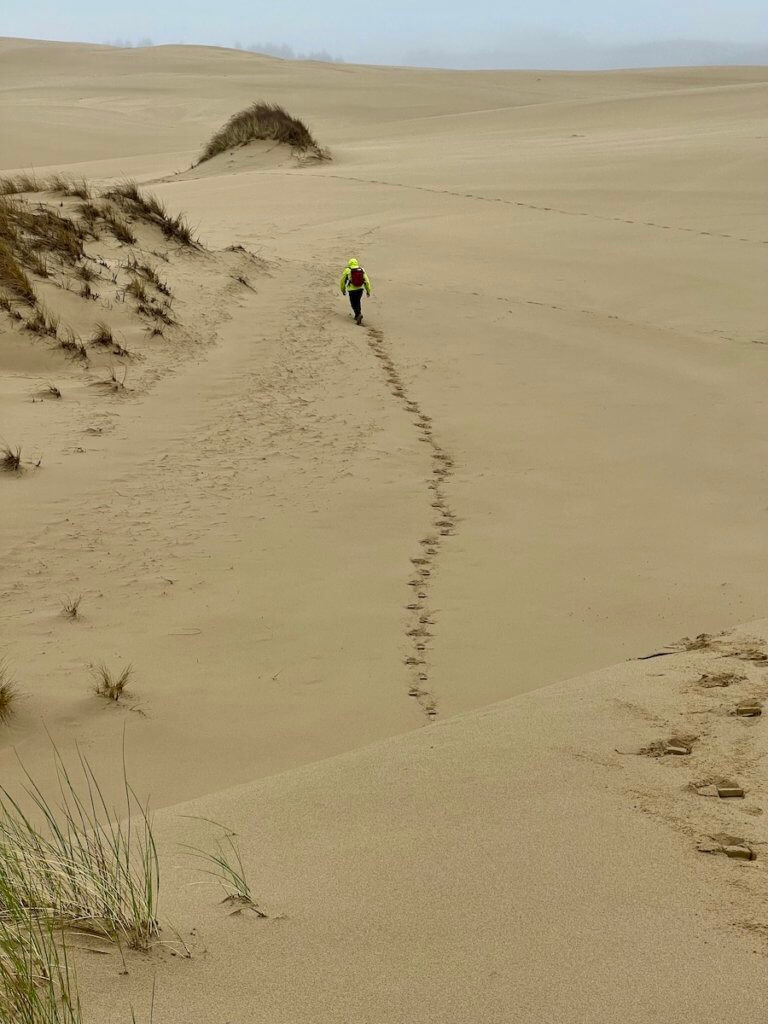
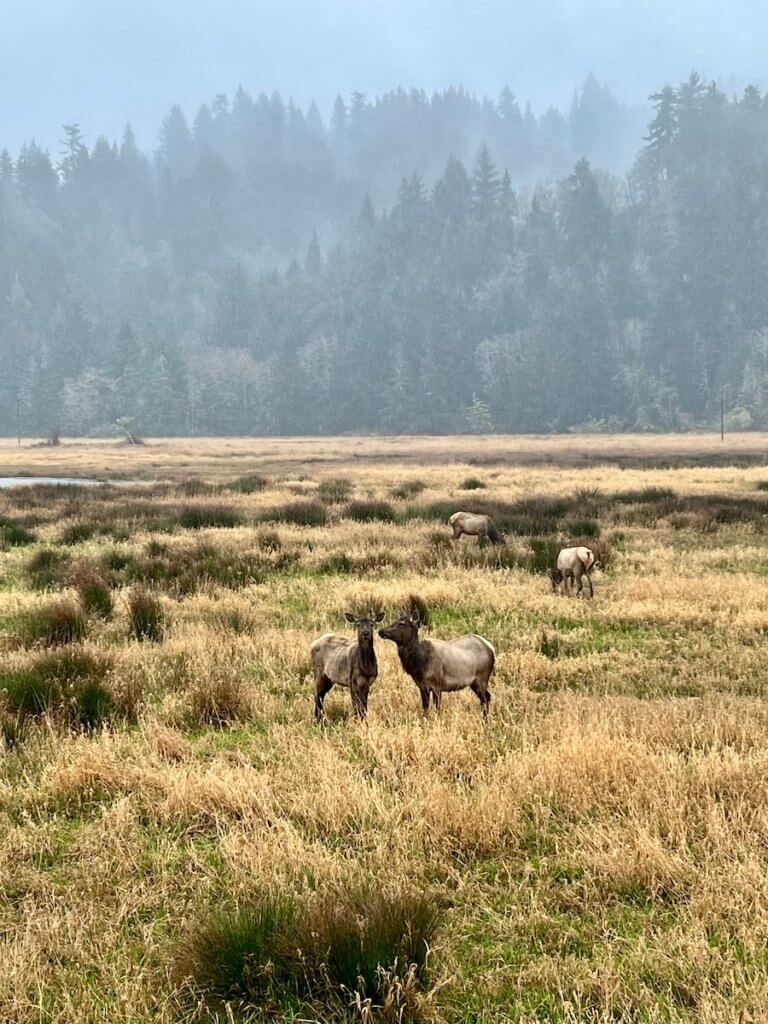
Wildlife on an Oregon Coast Road Trip
There are fabulous opportunities to experience wildlife on an Oregon Coast road trip. You’ll encounter Elk around Gearhart and Cannon Beach on the North Coast, sea lions at virtually any harbor or dock area, whales breaching, and all kinds of birds. And on this topic, please remember deer and elk meandering on Highway 101 around dusk. If you want to plan a wildlife experience into your journey, here are a few suggestions:
Oregon Coast Aquarium: The otters are a huge crowd pleaser, but this Newport fixture also has other interesting exhibits.
Sealion Caves: Very touristy but I still love taking the rickety elevator 200 feet below a cliff to a natural cave housing hundreds of loud and smelly sealions.
Whale watching: Depoe Bay is known for whales coming close to the shore to feed. Guided boat tours depart from here, as well as Newport, Brookings, and a few other locations.
Dean Creek Elk Viewing Area: Off Highway 101, along the placid Umpqua River, this is a great place to spot Elk.
Bird Watching: Nestucca Bay Wildlife Refuge offers excellent bird watching, but many places exist to explore.
Where to stay on the Oregon Coast
Numerous campgrounds are along the Oregon Coast, but I’ll focus on places to stay while on an Oregon Coast Road Trip. When considering hotels and homeshares, remember that there isn’t much new building happening here. This means that prices rise dramatically during busy times, including all summer, the end of March for spring break, and holiday weekends the rest of the year. If you plan to visit the Oregon Coast during these busy times, expect to pay significantly more and book well in advance (more than three months is ideal).
There are two main schools of thought when booking your Oregon Coast road trip stays. The first is utility, finding locations along Highway 101 that allow you to rest your head at night and then move on your way the next morning. In this case, there are numerous options along the entire coast—mostly still mom-and-pop places that are well worn by the stormy atmosphere.
The second is finding special places that offer soulful experiences—connecting with Nature on the premises. In this case, you’ll probably need to plan to spend more time in these locations to account for the typically higher costs.
I list my favorite soulful places in the Oregon Coast section of another article, 25 Hidden Oregon and Washington Hotels.
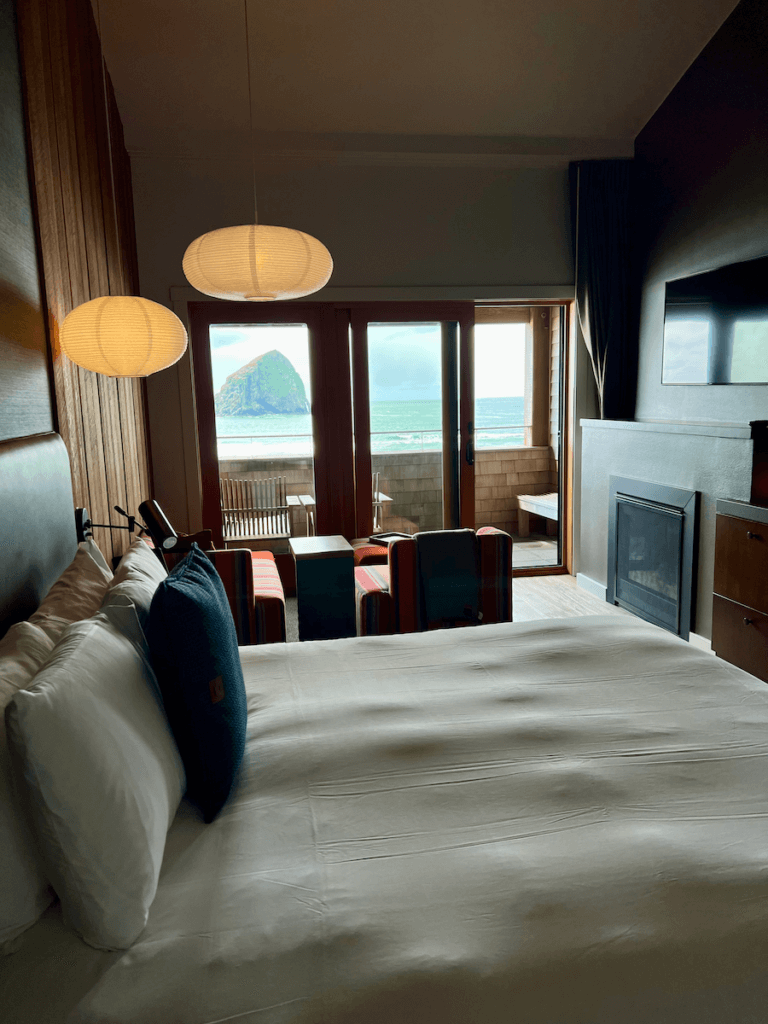
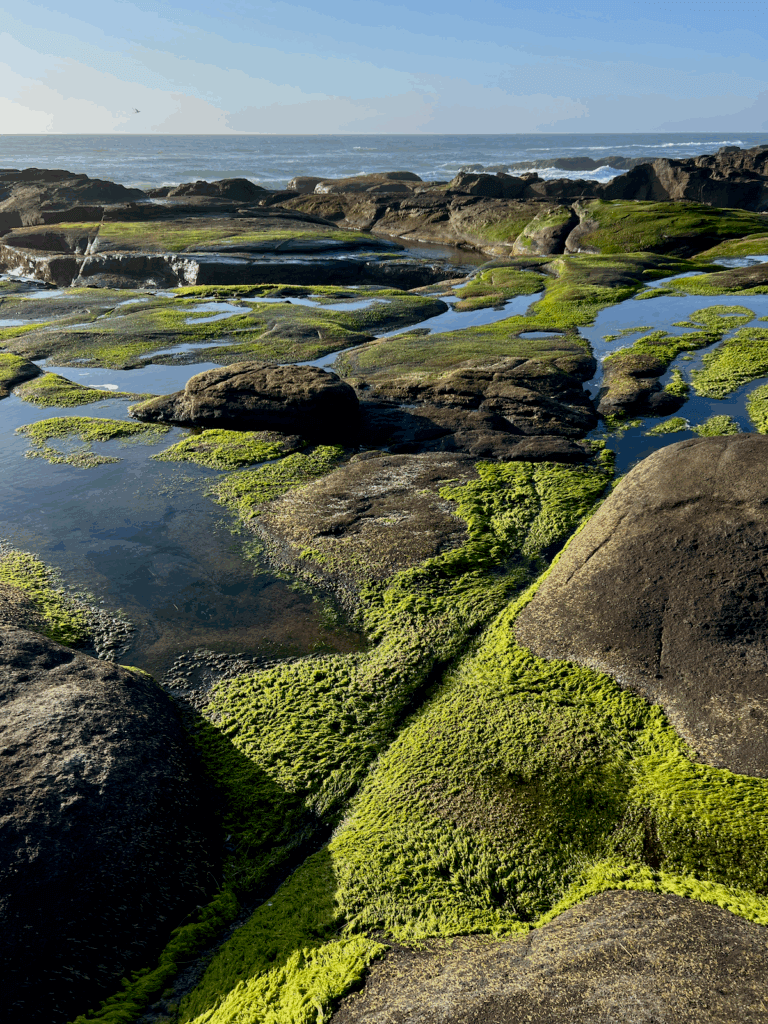
Itineraries for Oregon Coast road trips
There are many ways to enjoy a road trip in this wild part of Oregon. These are the most popular versions:
- The entire loop starts from Seattle/Tacoma or Portland area.
- Oregon Coast to Olympic Peninsula road trip.
- Seattle/Portland to San Francisco.
My itineraries take into account a mindful approach to nature. To read more about my suggestions for nature-forward travel and why it is essential, access a recent article HERE. Please take your time with your Oregon Coast Road Trip. There is too much to soak up in the natural wonders.
The entire Oregon Coast: 7-day itinerary from Seattle or Portland.
This itinerary gives you the complete 363-mile experience on the Oregon Coast. You can do it in either direction, using Interstate 5 to express one direction. Or, take a few more days and drive it in both directions. I love this because the weather nuances make every day a different experience, and you can enjoy new Oregon Coast Towns along the way.
If flying into Seattle/Tacoma (SEA), staying overnight and leaving early the next morning is best. You can also add a day of activities in Seattle. If arriving at Portland International Airport (PDX), it’s realistic to drive to the coast the same day, but be mindful of snarling traffic between 3 p.m. and 7 p.m. Exploring some of the Rose City might also be better, and then leaving for the Coast early the next morning.
My suggested lodgings are shown in italics.
Day 1: Early morning departure and drive to the Northern Oregon Coast. Arrive by noon at Astoria. Spend the afternoon exploring the town, Astoria Column, and Lewis & Clark National Historic Park. (Cannery Pier in Astoria)
Day 2: Full day on the North Oregon Coast. Wander on the beaches, walk to Haystack Rock, and explore Oswald West or Ecola State Park. (Surfsand in Cannon Beach)
Day 3: Early departure and continue to the Central Coast area. Stay in Depoe Bay, Newport, or Yachats. Pop into various rock stack features like the Devil’s Punchbowl or 805 Trail in Yachats. (Overleaf Lodge in Yachats)
Day 4: Continue to Heceta Head Lighthouse, explore tide pools, and hike to Hobbit Beach. Continue to North Bend/Coos Bay, stopping at a viewpoint of the Oregon Dunes. (Bay Point Landing in North Bend)
Day 5: Visit Shore Acres (photo shown), Cape Arago, and Sunset Bay State Parks, and continue to Bandon for lunch. Next is Cape Blanco, just before Port Orford. Stop at any of the many wonderful beaches before arriving in Gold Beach for an overnight. (TuTuTun Lodge in Gold Beach)
Day 6: Explore the nooks and crannies of Samuel Boardman State Scenic Corridor and enjoy lunch in Brookings. In the afternoon, visit one of the Oregon Redwood parks or continue to the Stout Creek area in northern California. You will end up in Cave Junction, Oregon. (Treehouse Vacations looks cool, though I haven’t stayed here)
Day 7: Return to Portland or Seattle. It’s 4.5 hours nonstop from Cave Junction to PDX, or 8 hours to Seattle. Silver Falls State Park, near Salem, Oregon, is a definite highlight relatively close to Interstate 5–allow an additional hour for the driving part.
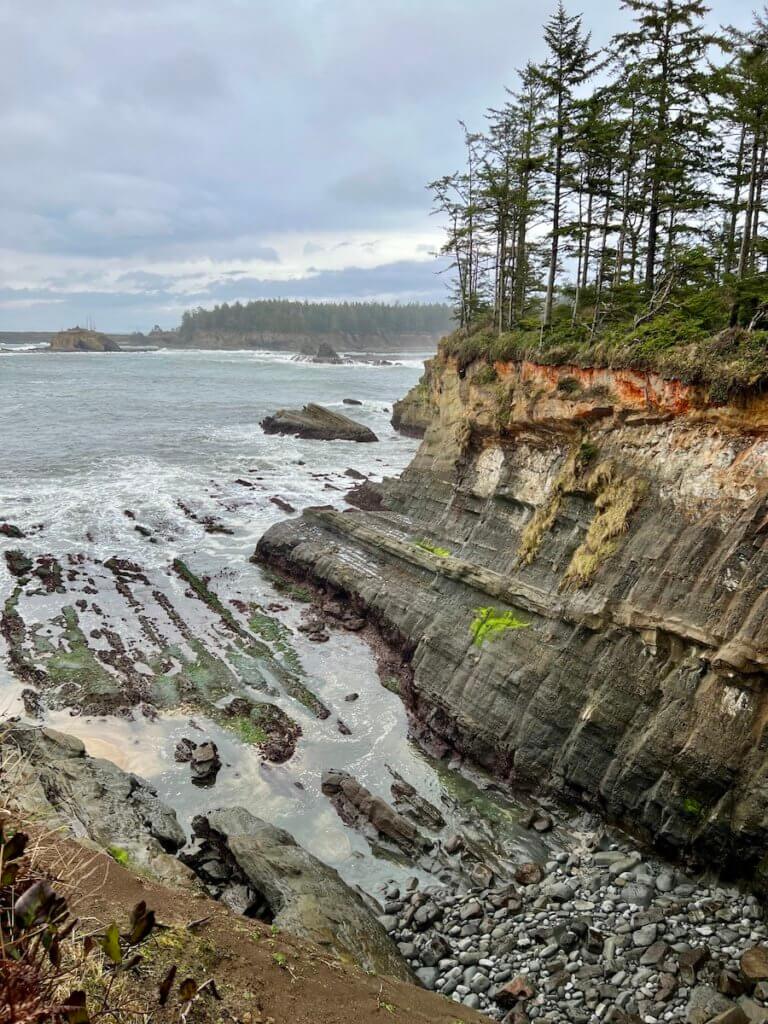
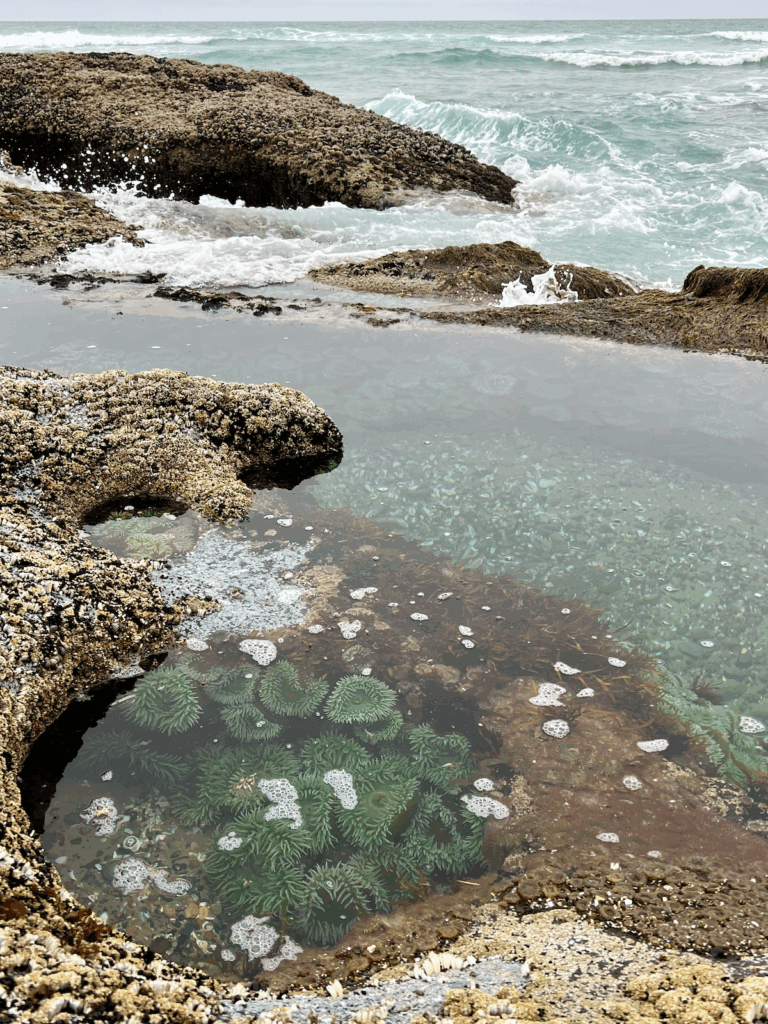
5-day itinerary from Seattle or Portland to the Oregon Coast.
Best if short on time, this itinerary allows two nights in each accommodation to avoid constant packing/unpacking. It also provides a bit more grounding along the way. And if time is a consideration, the return can be done faster by cutting over to Interstate 5 to return to PDX or SEA.
If flying into Seattle/Tacoma (SEA), staying overnight and leaving early the next morning is best. You can also add a day of activities in Seattle. If arriving at Portland International Airport (PDX), it’s realistic to drive to the coast the same day, but be mindful of snarling traffic between 3 p.m. and 7 p.m. Exploring some of the Rose City might also be better, and then leaving for the Coast early the next morning.
My suggested lodgings are shown in italics.
Day 1: Early morning departure and drive to the Northern Oregon Coast. Arrive by noon at Astoria, Seaside, or Cannon Beach. Spend the afternoon exploring the town and enjoying the beach. (Surfsand in Cannon Beach)
Day 2: Full day on the North Oregon Coast. Wander on the beaches, explore Oswald West or Ecola State Park. (Surfsand in Cannon Beach)
Day 3: Early departure and continue to the Central Coast area. Stay in Depoe Bay, Newport, or Yachats. Pop into various rock stack features like the Devil’s Punchbowl or 805 Trail in Yachats. (Overleaf Lodge in Yachats)
Day 4: Continue to Heceta Head Lighthouse, explore tide pools, and hike to Hobbit Beach. Return to lodging in Yachats, Newport, or Depoe Bay. (Overleaf Lodge in Yachats)
Day 5: Make your way back to Portland or Seattle.
Oregon Coast and Olympic Peninsula Itinerary from Seattle: 5 days.
Like the itineraries above, it is best to stay overnight in Seattle when you arrive. If you get in before or around noon, it is realistic to commence your road trip immediately.
My suggested lodgings are shown in italics.
Day 1: Ferry from Seattle to the Olympic Peninsula and enjoy lunch in Port Angeles. Continue to Lake Crescent Lodge and explore the mossy goodness of the Marymere Falls trail and the peaceful shore of Lake Crescent. Finish the day at Forks or LaPush, WA. (Woodland Inns in Forks)
Day 2: Visit Ruby Beach and continue to the Lake Quinault area. Visit the historic lodge and walk the Quinault Loop Trail to experience a magical old-growth forest. Kestner Homestead will provide beautiful mossy goodness that rivals the Hoh Rainforest. Stay at Lake Quinault Lodge or in the area, or push on to Westport, WA (but this is a much longer day). (Lake Quinault Lodge)
Day 3: Continue down Highway 101 and stop for brunch/lunch at the Tokeland Hotel. Keep going to the Oregon Coast and stay in Seaside or Cannon Beach. (Surfsand in Cannon Beach)
Day 4: Explore the beaches and parks of the Northern Oregon Coast. (Surfsand in Cannon Beach)
Day 5: Return to Seattle or Portland.
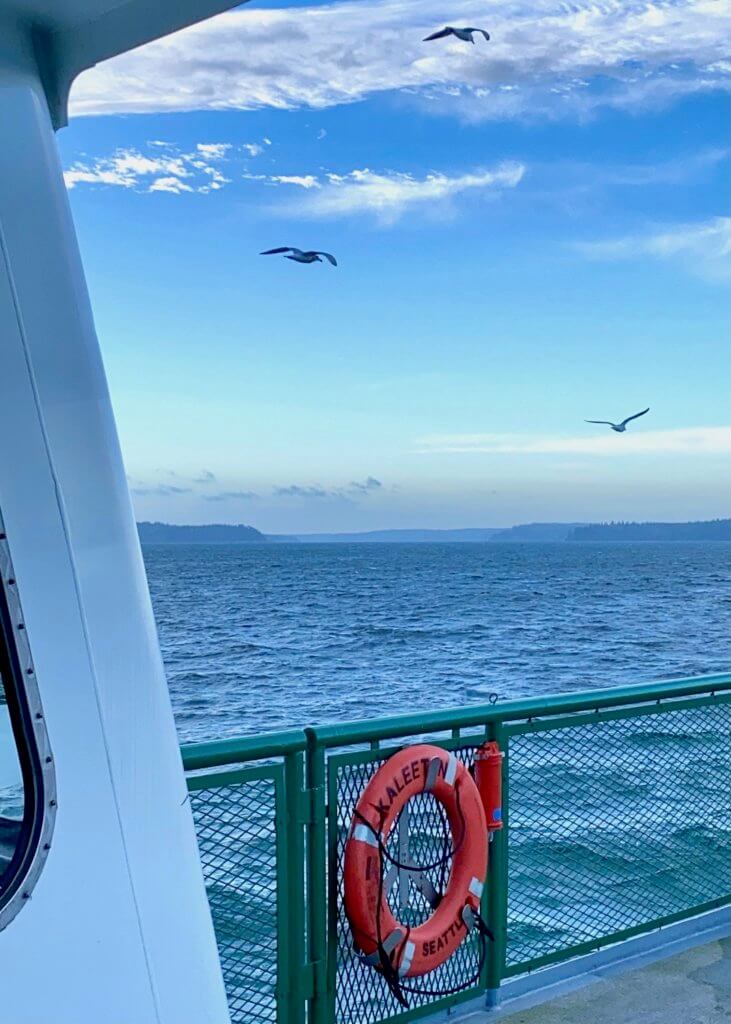
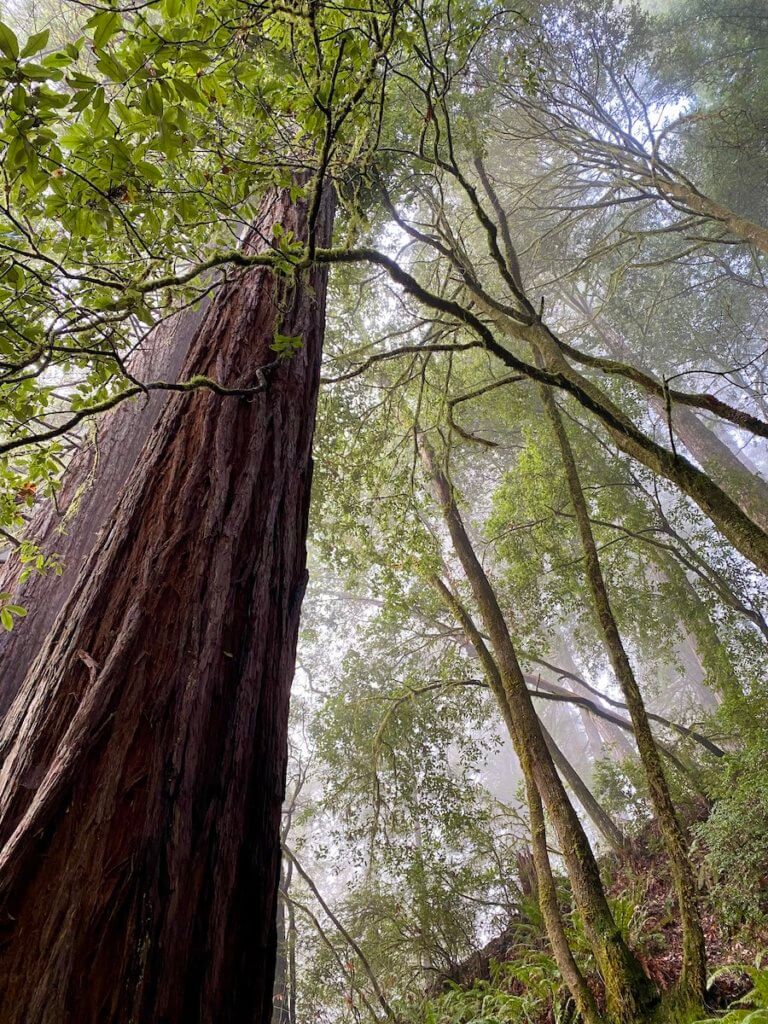
Seattle to San Francisco road trip: Oregon Coast 7 days.
Everyone always plans to do this trip without enough time. Please keep this in mind and try to allow as much flexibility as possible to spend time with meaningful experiences along the way. If you want to try the Olympic Peninsula, too (which people say is way too much afterward), allow for at least 10 days to two weeks.
The same assumptions hold true for this itinerary: Stay overnight in Seattle and leave early the next day. The same trip can also be done from Portland (PDX).
My suggested lodgings are shown in italics.
Day 1: Early morning departure and drive to the Northern Oregon Coast. Arrive by noon at Astoria, Seaside, or Cannon Beach. Spend the afternoon exploring the town and enjoying the beach. (Surfsand in Cannon Beach)
Day 2: Early departure and stop at Oswald West State Park, then continue to the Central Coast area. Stay in Depoe Bay, Newport, or Yachats. Pop into various rock stack features like the Devil’s Punchbowl or the 805 Trail in Yachats. (Overleaf Lodge in Yachats)
Day 3: Continue to Heceta Head Lighthouse, explore tide pools, and hike to Hobbit Beach. Move on to a late lunch in the Florence waterfront area and visit the Oregon Dunes before finishing the day in the Coos Bay/North Bend area. (Bay Point Landing in North Bend)
Day 4: Visit Shore Acres State Park and continue south through Bandon and Port Orford. Stay in Gold Beach. (TuTuTun Lodge for higher-end, or another beachfront motel)
Day 5: Make a stop or two at Samuel Boardman State Scenic Corridor and continue into California to visit the redwoods. Stay overnight in Crescent City, Klamath, or my favorite, Orick, CA. (Roosevelt Camp in Orick)
Day 6: Spend the day in the Redwoods. Jebediah Smith, Stout Creek, or my favorites around Orick, CA. My favorite is Lady Bird Johnson Grove. (Roosevelt Camp in Orick)
Day 7: Continue to San Francisco. Breakfast in Trinidad or Arcata, and other stops as desired along the way.
Travel to and from the Oregon Coast
Most visitors make road trips on the Oregon Coast in one of three ways:
- Begin/End in Portland (PDX Airport).
- Begin/End in Seattle and inlcude the Olympic Peninsula with Northern Coast.
- Travel between Seattle/Portland and San Francisco.
Getting between Portland and the Oregon Coast
You’ll need a vehicle for a road trip on the Oregon Coast. If you’re travelling to the Northern Oregon Coast, it is realistic to fly into Portland International Airport (PDX) and drive the 90 minutes to points from Astoria to Manzanita all in the same day. When leaving PDX on flights departing before noon, staying at or near PDX the night before is recommended.
Olympic Peninsula road trip
Many visitors desire to fly into Seattle and combine the Olympic Peninsula with an Oregon Coast road trip. This is usually way too much to pack into a short itinerary of less than a week. With out-of-town guests short on time, I drive from Seattle to the Northern Coast (Cannon Beach or Seaside) and stay a night or two before returning via the Olympic Peninsula.
Other visitors use this opportunity to take a more extended road trip between San Francisco and Seattle (or Vancouver) through the Oregon Coast and Olympic Peninsula. You’ll need at least ten days to do this without rushing. If so, I have many resources about the Olympic Peninsula.
Travel distances to the Oregon Coast
Otherwise, here are a few landmarks to help plan your Oregon Coast road trip distances. These estimated drive times do not account for stopping along the way (you should, of course!)
Portland International Airport (PDX) to:
- North Coast (Astoria, Cannon Beach, Manzanita) — About two hours.
- Newport — About three hours.
- Bandon (fastest way, inland Intertate 5) — About five hours.
- Brookings — About 6.5 hours.
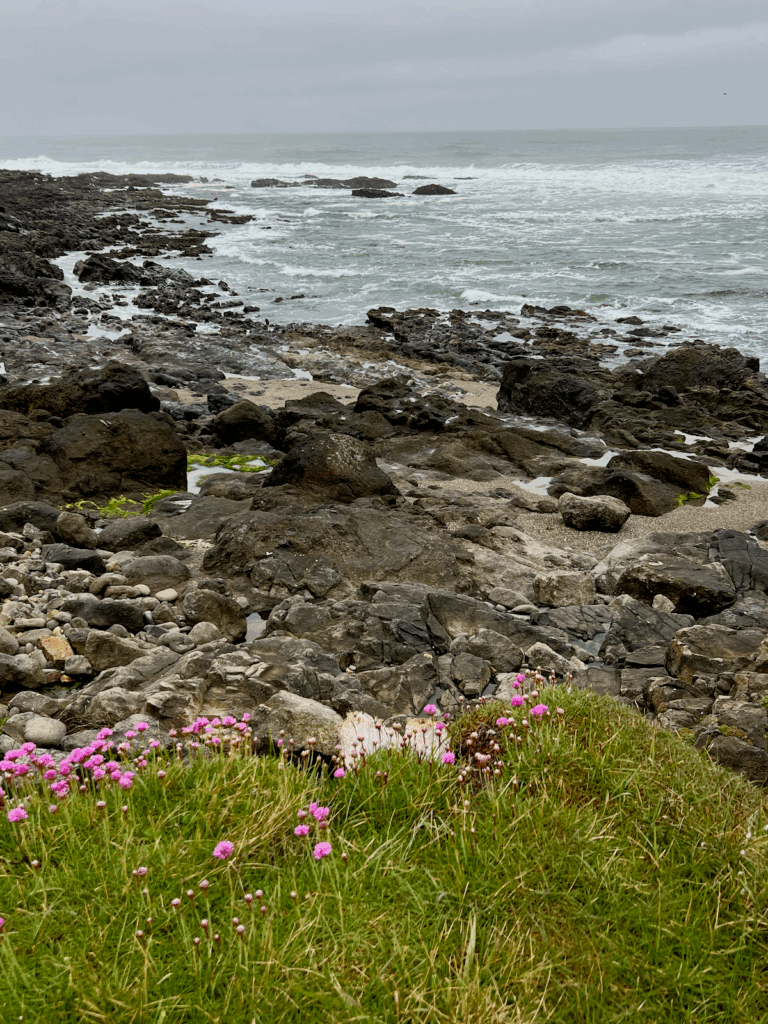
Oregon Coast road trip FAQ
The 363-miles of Pacific Wonderland lends itself to a lot of questions, especially if you’re a new visitor. Even local Oregonians who might be used to only certain sections of the Oregon Coast might need a refresher.
Why should I listen to you, Matthew?
Fair question. For several reasons, my information can be more helpful than loads of other online content.
- I grew up about 60 miles from the Oregon Coast, and while I live in Seattle today, I’ve spent my entire life visiting destinations up and down the pristine coastline. This includes several recent “refresher” road trips along all 363-miles of beautiful Pacific Ocean. Every time of year, for family reunions, spiritual retreats, hiking with friends, partying with friends, romantic getwawys, and road trips designed specifically for me to connect more closely with nature.
- Companies like BlimpAdvisor and online agencies have built their business models around pushing products for you to buy rather than providing unbiased information. If it doesn’t make them money, they won’t provide the information you need to make your decisions.
- Travel Oregon and local tourism chambers have to promote all their “clients” and therefore steer clear of favoritism, which means they aren’t able to really give you an actual opinion. They are very helpful overall in offering information though.
- Unless specifically stated, I don’t receive any financial compensation for recommending a restaurant, hotel, or hiking trail. You can rest assured my suggestions are my own opinion — and have been tried, tested, or locally suggested by my trusted friends.
- For all the above reasons, my content is not designed to promote tourism, but more to help you connect to the healing powers of nature. To enjoy the Oregon Coast, however, I realize you need to plan things like lodging, food, where to go to hike, driving information, etc. I can help.
- My spiritual journey has been one of amazing transformation from a person who rushed and succumbed to travel anxiety toward a calming inward peace that guides my movement. I understand what it’s like to try to move from a hectic daily life to connecting with nature. I’ve lived in nature my whole life, but I have found better techniques to quickly connect that I can share with you–and help you integrate it into your own experience, enjoying a meaningful connection on the Oregon Coast.
How much time will I need?
In order to truly connect with nature, plan to spend at least three hours a day actually on the land. This means hiking, sitting on the beach, or strolling a promenade where you are mostly surrounded by organic things. This shouldn’t include your downtime (at campsite, Airbnb, or motel).
Add another hour each day of “connection” time for reading informational placards, visiting museums, and/or researching local indigenous peoples.
The general rule I use to calculate driving time is 45 miles per hour. This accounts for speed zones in towns and stopping for quick restroom breaks — in normal traffic. Summertime clogs with numerous RVs and just more visitors can lower this to about 35-40 miles per hour.
With this math, if you drive three hours each day (and apply the “connection” times I recommend), in the thick of summer you can drive the entire coastline in three whole days (four overnights) — allowing for about seven hours of active itineraries.
Of course, this is the bare minimum. I’ve done the trip in three days, (which made for long days to do what I wanted), but enjoyed a version that was four whole days (five nights) much better. The extra day feels significant to me. A week would be ideal — especially for a first-time visitor.
I’ve created sample itineraries for the three options (3, 5, and 7 days).
When to road trip on the Oregon Coast
The weather on the Oregon Coast is cooler on the northern end (Astoria) and more like California from Port Orford south to the border. While the temperatures are mostly mild year-round (the 40s to 60s), I felt the chill of several 38-degree days recently in April. Typically with the colder temperatures, the skies are clear, which means there is the sun.
Even in winter it rarely gets to freezing, but it is a humid, bone-chilling cold. I love to watch the dramatic skies and angry waves crashing onto the shore. Expect to experience a lot of rain and wind from November to February. It is also much darker in the winter, limiting the duration of outdoor activities like hiking. Services also have greatly reduced hours of operation, if they’re open at all — but you can land great lodging deals (especially mid-week).
Spring is similar to winter with warmer temperatures and more frequent pockets of beautiful crisp days. I appreciate that the days are getting longer, so there is more opportunity to enjoy hiking and other outdoor activities without being too hot or crowded. Services start waking up, but many places are still closed mid-week. My annual road trip along the Coast is usually around the second week of April with excellent results.
Summer is the most popular time for visitors because the weather is much warmer and sunnier with a full complement of daylight until 9 pm. Services are at full speed but because of this, lodging can be much more expensive. And it gets BUSY — even mediocre camping sites fill up way in advance.
Fall is my favorite time of year. It’s the right mix of decent weather, enough daylight to spend outdoors, fewer visitors, better pricing and availability, and the slight autumn chill in the air that opens my heart.
The first week in October (or around then) is my favorite time to visit the Oregon Coast.
What to wear
The weather on the Oregon Coast is mild year-round, with an omnipresent chance of precipitation. Always have a good waterproof jacket, and even when the daytime temperatures creep into the 80s, a hoodie is still required once the sun drops below the horizon. Flip flops are practical year-round for running to and from the car or pool areas, but please be very careful when climbing on rocks or hiking as it’s easy to slip, and the rocks are very unforgiving!
Winter — I take a lightweight pair of silk underwear (or equivalent) as a base layer, excellent raingear (rainpants too for hiking), and good waterproof footwear. Boots are a good idea. Otherwise, like in other places in the Pacific Northwest, layering is key. Hats, gloves, warm socks, etc.
Spring/Fall — It’s still important to have a waterproof jacket and footwear available if you plan to be hiking or doing many beach walks. There might also be days when shorts are more comfortable. Don’t forget sunscreen and a hat for the surprise sunny days that are frequent.
Summer — Layers are important because it cools down a lot after sunset. A thick hoodie is a great thing to have, in addition to button-up shirts and of course a waterproof jacket — this will also serve you well with the wind. Flip-flops can be more comfortable on the beach but be careful to have good footwear if you plan to hike or explore any rocky areas.
Pro-tips
The first pro-tip is understanding that many people call the Oregon Coast their home. While tourism is the main source of economic vitality, please consider your impact on the local humans, as well as the animals and environment in general. For example, don’t park in a residential driveway or drive across someone’s lawn to turn around at a dead-end road (this happens in places!).
There are many more — enough to write a dedicated article that is linked by clicking the button below.
Final pro-trip — go glow. I know it can be hard to do, especially when trying to keep an itinerary. Look at the next topic line for more information.
How do I “go slow?”
It can be tough to relax and decompress, especially because of daily life’s demands. I get it. I’m also prone to travel anxiety — funny because I write about travel. But this means I understand how hard it can be to chill out and open up to a meaningful Nature Connection, especially on a road trip along the Oregon Coast.
Make it a point to connect with nature meaningfully every day — for up to three hours. This doesn’t have to be challenging hiking; you can walk on the beach or sit on a blanket, burying your toes into the sand. This is the time to avoid cell phones, social media, and other distractions.
If you’re with family and/or friends three hours might be totally unrealistic. I get it. Still… try to find a few minutes of alone-time to sit on the beach, or a lawn, or climb a tree (just kidding…) and for that ten minutes focus on something organic and nothing else.
My work leading people into the Natural World on Forest Bathing, wellness retreats, and outdoor meditation sessions led to the creation of a helpful guide. It’s called Six Questions to Deepen your Nature Connection. Clients find it very useful framework when road tripping on the Oregon Coast.
What are the “not to miss” items for an Oregon Coast road trip?
When working with people planning their epic Oregon Coast Road Trip, I suggest prioritizing key experiences to enjoy, rather than specific “not to miss” places. With this filter, I suggest these key experiences:
- Rock Stacks (like Ecola State Park)
- Visiting an old-growth or mature forest (like Oswald West State Park)
- Walking on an endless sandy beach (for example Gold Beach)
- A lighthouse (like Yaquina Bay in Newport)
- The Oregon Dunes
- A waterfront/wharf (like Newport or Astoria)
- Wildlife (spotting whales from Depoe Bay)
Where can I get information for all the towns on the Oregon Coast?
There are about 21 main towns on the Oregon Coast. I know because I’ve been to them all, and stayed overnight in most too. I’ve created a great overview that breathes life into the nuances of each. Even my local friends share this article with their friends visiting. Check it out below.
What are the best towns on the Oregon Coast?
Ask any Oregonian and they’ll tell you as many answers about the best places on the Oregon Coast. Even for me, it varies based on what it is I’m seeking. If it’s food and fun, definitely Astoria. If I have more time and want better access to nature, I’d choose Port Orford. The link below takes you to all my favorites in ten different categories — all designed to help you narrow in on your key desires.
Oregon Coast road trip highlights — use this map to help pave the way.
This map is a collection of my favorite Oregon Coast Road Trip stops, including lodging and restaurant experiences.
Unless noted, I have been to all these locations and hope you enjoy them as much as I do.
These suggestions are my point of view — I do not receive compensation for placement on the map or written articles unless expressly noted.
